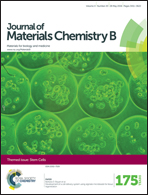Pluripotent stem cell derived hepatocytes: using materials to define cellular differentiation and tissue engineering
Abstract
Pluripotent stem cell derived liver cells (hepatocytes) represent a promising alternative to primary tissue for biological and clinical applications. To date, most hepatocyte maintenance and differentiation systems have relied upon the use of animal derived components. This serves as a significant barrier to large scale production and application of stem cell derived hepatocytes. Recently, the use of defined biologics has overcome those limitations in two-dimensional monolayer culture. In order to improve the cell phenotype further, three-dimensional culture systems have been employed to better mimic the in vivo situation, drawing upon materials chemistry, engineering and biology. In this review we discuss efforts in the field, to differentiate pluripotent stem cells towards hepatocytes under defined conditions.

- This article is part of the themed collections: 2016 Journal of Materials Chemistry B Most Accessed Manuscripts and Stem Cells


 Please wait while we load your content...
Please wait while we load your content...